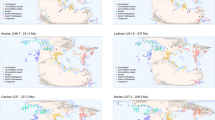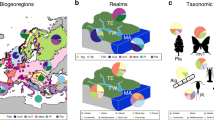Abstract
How quickly does biodiversity rebound after extinctions? Palaeobiologists have examined the temporal, taxonomic and geographic patterns of recovery following individual mass extinctions in detail1,2,3,4,5, but have not analysed recoveries from extinctions throughout the fossil record as a whole. Here, we measure how fast biodiversity rebounds after extinctions in general, rather than after individual mass extinctions, by calculating the cross-correlation between extinction and origination rates across the entire Phanerozoic marine fossil record. Our results show that extinction rates are not significantly correlated with contemporaneous origination rates, but instead are correlated with origination rates roughly 10 million years later. This lagged correlation persists when we remove the ‘Big Five’ major mass extinctions, indicating that recovery times following mass extinctions and background extinctions are similar. Our results suggest that there are intrinsic limits to how quickly global biodiversity can recover after extinction events, regardless of their magnitude. They also imply that today's anthropogenic extinctions will diminish biodiversity for millions of years to come.
This is a preview of subscription content, access via your institution
Access options
Subscribe to this journal
Receive 51 print issues and online access
$199.00 per year
only $3.90 per issue
Buy this article
- Purchase on Springer Link
- Instant access to full article PDF
Prices may be subject to local taxes which are calculated during checkout



Similar content being viewed by others
References
Hallam, A. Why was there a delayed radiation after the end-Palaeozoic extinctions? Hist. Biol. 5, 257–262 ( 1991).
Jablonski, D. Geographic variation in the molluscan recovery from the end-Cretaceous extinction. Science 279, 1327–1330 (1998).
Jablonski, D. in Extinction Rates (eds Lawton, J. H. & May, R. M.) 25– 44 (Oxford Univ. Press, New York, 1995).
Erwin, D. H. The end and the beginning: recoveries from mass extinctions. Trends Ecol. Evol. 13, 344–349 (1998).
Sepkoski, J. J. Jr Rates of speciation in the fossil record. Phil. Trans. R. Soc. Lond. B 353, 315– 326 (1998).
Walliser, O. H. in Global Events and Event Stratigraphy in the Phanerozoic (ed. Walliser, O. H.) 7–19 (Springer, Berlin, 1996).
Kirchner, J. W. & Weil, A. No fractals in fossil extinction statistics. Nature 395, 337– 338 (1998).
Schulz, M. & Stattegger, K. SPECTRUM: Spectral analysis of unevenly spaced paleoclimatic time series. Comput. Geosci. 23, 929–945 (1997).
Agterberg, F. P. in Geostatistics (ed. Merriam, D. F.) 113– 141 (Plenum, New York, 1970).
Bracewell, R. N. The Fourier Transform and its Applications 3rd edn (McGraw Hill, Boston, 2000).
Scargle, J. D. Studies in astronomical time series analysis. III. Fourier transforms, autocorrelation functions, and cross-correlation functions of unevenly spaced data. Astrophys. J. 343, 874–887 (1989).
Lomb, N. R. Least-squares frequency analysis of unequally spaced data. Astrophys. Space Sci. 29, 447–462 ( 1976).
Press, W. H. & Teukolsky, S. A. Search algorithm for weak periodic signals in unevenly spaced data. Comput. Phys. 2, 77–82 (1988).
Scargle, J. D. Studies in astronomical time series analysis. II. Statistical aspects of spectral analysis of unevenly spaced data. Astrophys. J. 263 , 835–853 (1982).
Sepkoski, J. J. Jr in Global Events and Event Stratigraphy in the Phanerozoic (ed. Walliser, O. H.) 35–51 (Springer, Berlin, 1996).
Sepkoski, J. J. Jr Ten years in the library: new data confirm paleontological patterns. Paleobiology 19, 43– 51 (1993).
Signor, P. W. & Lipps, J. H. Sampling bias, gradual extinction patterns, and catastrophes in the fossil record. Geol. Soc. Am. Special Paper 190, 291–296 (1982).
Gilinsky, N. L. in Analytical Paleobiology (eds Gilinsky, N. L. & Signor, P. W.) 157–174 (The Paleontological Society, Knoxville, Tennessee, 1991).
Cleveland, W. S. & McGill, R. The many faces of a scatterplot. J. Am. Stat. Assoc. 79, 807–822 (1984).
Acknowledgements
We are indebted to the late J. Sepkoski for his fossil databases and his encouragement, and we thank M. Foote and D. Erwin for comments on the manuscript. Our work was supported by grants from the University of California and the NSF to J.W.K.
Author information
Authors and Affiliations
Corresponding author
Supplementary Information
Rights and permissions
About this article
Cite this article
Kirchner, J., Weil, A. Delayed biological recovery from extinctions throughout the fossil record . Nature 404, 177–180 (2000). https://doi.org/10.1038/35004564
Received:
Accepted:
Issue Date:
DOI: https://doi.org/10.1038/35004564
This article is cited by
-
Diversity on the rebound
Nature Ecology & Evolution (2019)
-
Phytoplankton growth after a century of dormancy illuminates past resilience to catastrophic darkness
Nature Communications (2011)
Comments
By submitting a comment you agree to abide by our Terms and Community Guidelines. If you find something abusive or that does not comply with our terms or guidelines please flag it as inappropriate.



